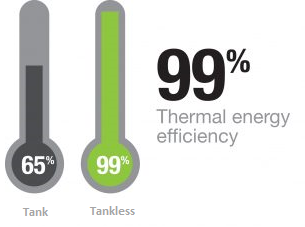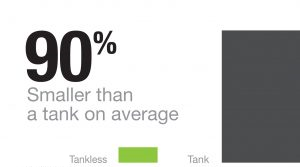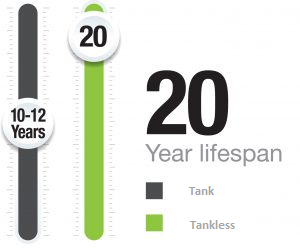WHY ELECTRIC TANKLESS INSTANT WATER HEATER?
| – 99.8% thermal energy efficiency. Most storage water heater tanks are 35-65% efficient. – No standby heat loss. Heat water when you want it, instead of keeping water hot 24/7 – Saving energy reduces your carbon footprint and also saves you on your electricity bills |  |
 | – Most storage water heaters or Geysers have a warranty of 5-10 years. – Were as Tankless provides you with a limited lifetime warranty, ensuring that you will enjoy the product for a long time |
– Electric tankless water heaters are 90% smaller than a storage water heater /Geyser/tank type heater, allowing you to place them almost anywhere. – Because they are so small, they can be installed at the point of use, so you don’t have to waste water waiting for your water to heat up. |  |
 | – Electric Tankless water heaters can last over 20 years, much longer than any other storage water heater/Geysers or Tank heater – Geysers and Storage Water heaters only last 10-12 years. |
Electric Tankless Instant water heater unlocks
- Extra space,
- Reduce energy consumption
- Reduce the ongoing cost to residents on energy bills
Electric Tankless water heaters use the latest technology to provide an endless supply of hot water. Heating water only when it's needed provides greater savings not found with conventional water heaters/storage tanks/Geysers.
Here are just some of the benefits:
- Energy Savings: Save by heating water only when you need it. You can reduce your hot water heating costs by approximately 60%. Please note: approximately 30% of your total heating costs are from your water heater.
- Convenience: You do not need to wait for water to heat up and to take a shower. Electric Tankless water heater heats water in less than 3 seconds and you get 3 liter per minute with no recovery time.
- Comfort: Continuous supply of hot water throughout your shower. Tankless water heaters heat water on demand so you're not limited by a fixed pre-heated supply as with a conventional tank.
- Safety: Temperature control at the touch of a button can be set to exact user desired hot shower preference
- Flexibility: Tankless water heater can be placed in virtually any room. Traditional storage tanks can take up to 16 sq. ft. of floor space.
KEY ADVANTAGES
From energy saving to reducing monthly electricity bills, Electric tankless water heaters offer several performance features that make them the preferred choice for residents and households.
Instantaneous Heaters are Compact
The hot water tank is the largest piece of equipment in conventional heating installations, and this can be an issue when space is a limitation. Thus, tankless water heaters are common in single-person apartments, tiny houses, and other dwellings of similar size.
The size advantage is especially true for point-of-use heaters, which can be easily installed on a wall next to a sink, shower or faucet.
Instantaneous Heaters Save Energy in Most Applications
Storage water heaters constantly consume energy just to keep the water in the tank at a desired temperature. This waste of energy is prevented by tankless heaters, and although their savings vary by project, they can exceed saving of 30 - 60% in most cases.
Electric tankless heaters are more cost effective to operate than their storage-based counterparts; it happens if hourly electricity rates are applied and if the heater is used extensively precisely when peak rates are being charged.
Design Flexibility in New Installations
Another significant advantage of instantaneous heaters is that, since no storage tank is used, there is flexibility with regards to how the installation is configured:
- A single heater can be deployed for an entire household.
- Multiple point-of-use heaters can be used at strategic locations.
- A combination of both approaches.
Using a single heater is the recommended choice when there is a consistent and predictable water heating load that will demand the unit’s full capacity. On the other hand, point-of-use heaters are the top choice when there are just a few spots with variable consumption, for example two bathrooms and a kitchen faucet in a small apartment.
Tankless Heaters have a Superior Service Life
Another significant advantage of tankless heaters is their long service life: they typically last for 20 years or more, while heat pumps and conventional storage heaters normally last for 8 to 10 years. Even solar heaters aren't that comparable to that of electric tankless heaters.
A tankless heater may seem slightly expensive in terms of upfront costs, but consider replacing two conventional heaters over its service life. You will be avoiding the cost of the replacement storage heater, as well as the associated labor cost.
Avoid Down Time (Commercial Settings or Installation)
For many businesses, having hot water for clients is part and parcel of the experience they provide – it’s a necessity that directly connects to the bottom line.
“If you don’t use a lot of hot water, tankless is simply nice to have. But if your demand is high and your business depends on hot water, you can’t afford to have down time if you run out,”
Example & Possible Scenario: Think of settings such as a hotel, hair salon, or spa – customers walk away dissatisfied if they aren’t provided with services that depend on hot water. It can be equally disastrous for a restaurant to have to close their doors for health reasons if enough hot water isn’t available. Tankless technology ensures these scenarios are obsolete.
Maintenance
Most water heaters receive little upkeep and consequently have to be replaced at the first sign of failure. Rather than a total replacement, individual parts of a tankless heater can be exchanged to extend its life.
“The heat exchanger is the most important component. “A total flush is needed periodically, which could be annually or every three to five years depending on water hardness.”
Tankless water heaters use flash heating tech that needs to be cleaned or descaled.
Periodic flushing should be done once a quarter or every year depending on water quality. You can use inexpensive products such as white vinegar (Citric Acid) or a lime-and-rust remover. You should also perform a full drain.
Retrofit Considerations
Some facilities have oversized water heaters in the first place. Tankless can be scaled to your actual water demand.
“You don’t replace a water heater with a tankless unit based on the original storage capacity – you size the tankless model based on your hot water demand.
Sizing evaluates a number of factors. Look at the number of fixtures that use hot water, their liters per minute rate, and peak demand. You also need to know the source water temperature coming in through your pipes, which affects how much energy is needed to raise the temperature to the setpoint.
Recommendation
Installing a tankless heater as close as possible to the point of end use is best as less energy will be lost as water is transported throughout your building. Otherwise, you need a recirculation pump and line, which will keep the water at the correct temperature. You can also add a timer and aquastat for additional control.
Lastly, shop around for installation costs. The plumbing technician should also have familiarity with these units, otherwise improper installation could negate future savings.
Information Source: https://www.buildings.com/article-details/articleid/18483/title/3-reasons-to-switch-to-tankless-water-heating/viewall/true